This is a true story of Japanese ghost troops who were killed in fierce battles on an island in the South Pacific about 80 years ago and returned to Japan as ghosts.
In the former article, I introduced a ghost story about the ghosts of soldiers of the Ichiki Detachment, who were all killed in battle on Guadalcanal Island on August 21, 1942, and returned to their barracks in Asahikawa, Hokkaido, Japan, about 3,850 miles away from the island on the same day.
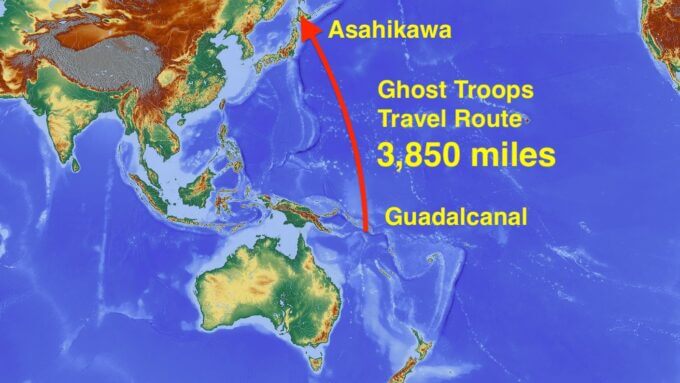
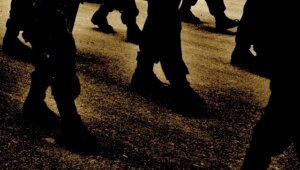
Ghost Soldiers of the Ichiki Detachment Appeared to Their Families
However, the 7th Division headquarters and the 28th Infantry Division headquarters were eager to cover up these ghost troops’ sightings. This was because the Japanese military top brass feared that if rumors of the return of these ghost troops were leaked to the outside world, the Japanese public would learn of the actual war situation in which the Japanese forces were struggling against the Allied forces to the extent that the elite Ichiki Detachment was wiped out.
Therefore, they first decided to prohibit the soldiers from going out for the time being. They also strictly censored mail from the soldiers and took care to prevent rumors of ghost troops from leaking outside. In addition, the Asahikawa Kenpeitai (military police) began to investigate and interview witnesses to the ghost troops, and even boarded the commuter trains of Asahikawa junior high school students to prevent rumors from spreading.
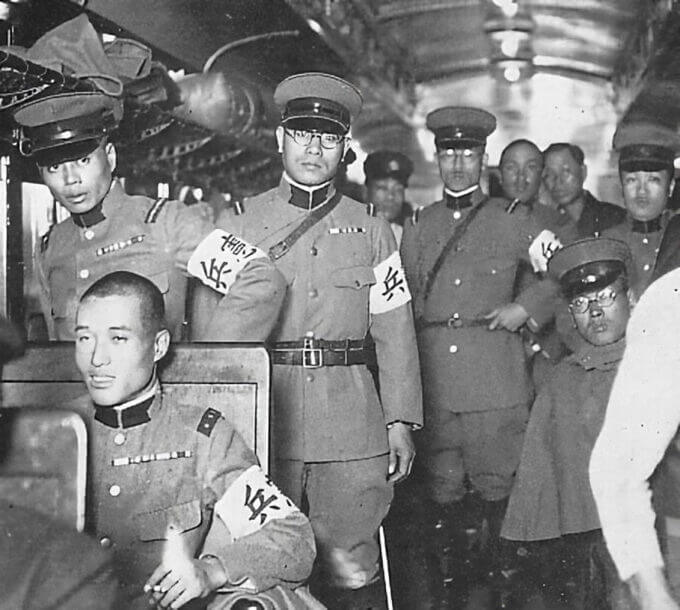
Meanwhile, the personnel officers of the 28th Infantry Division set up sleepless guards to monitor the second-line barracks where ghost troops had been sighted, and they themselves stayed in the barracks, taking soldiers on patrols and inspections to try to eliminate the source of the rumors.
However, despite these desperate measures taken by the 7th Division Headquarters and the 28th Infantry Division Headquarters, rumors of the return of the ghost troops did not abate. This is because the ghost soldiers of the Ichiki Detachment, who first returned to the barracks, then began to appear to their families as well.
Strange Noises Heard by Officer’s Wives on the Night the Ichiki Detachment Was Annihilated
On the vast grounds of the 7th Division, in addition to the barracks of the core 26th, 27th, and 28th Infantry Regiments, there was also a military housing area for the out-of-town families of Ichiki Detachment officers, where women and children lived, eagerly awaiting the return of their husbands and fathers.
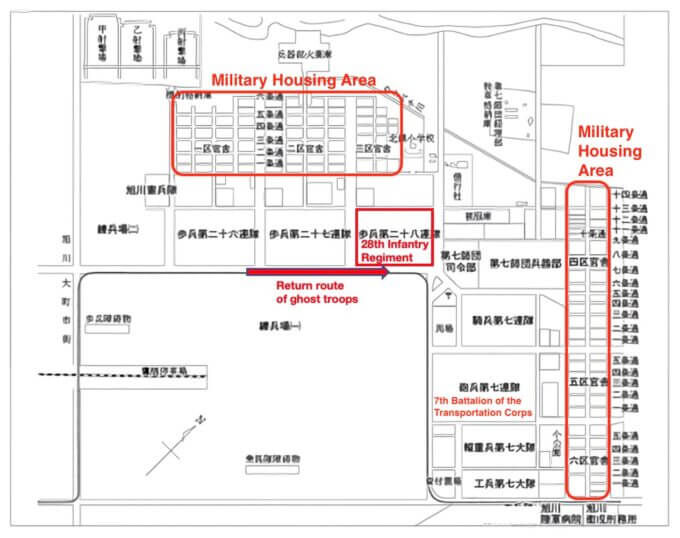
The ghost troops marched toward the barracks of the 28th Infantry Regiment along the route indicated by the red arrow.
Later, the ghost troops also appeared to their families in the military housing area.
The wife of the company commander of Ichiki Detachment resided in military housing on the back street of the barracks of the Transportation Regiment on the southeast side of the 7th Division’s site.
Late at night on August 21, she suddenly awoke to the sound of several Transportation vehicles (vehicles carrying arms, ammunition, food, and other military supplies) rattling and moving with the sound of loud wheels, and the sound of soldiers talking to each other in a buzzing voice.
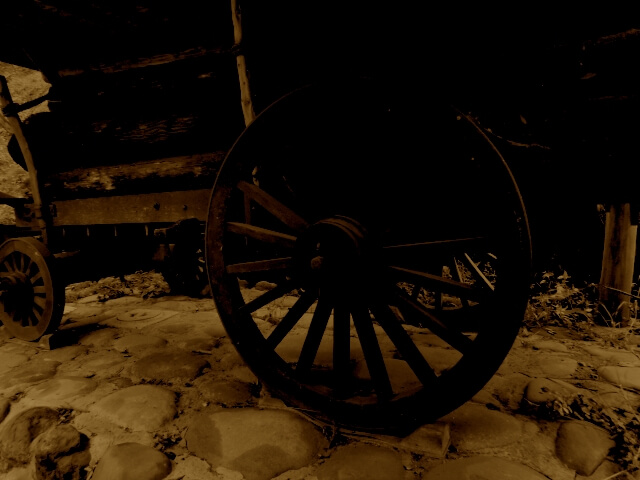
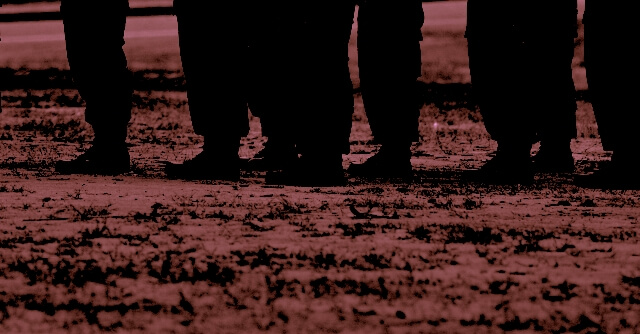
She opened a shoji (sliding paper screen) to see what was going on, but there was not a soul to be seen on the wide street, only darkness. This mysterious “sound” was also heard by a wife in the government building next door and a daughter in the government building across the street.
After recounting their strange experiences with each other, the women looked at each other and said, “Maybe…” but could say nothing more. Since the Transportation Corps was also part of the Ichiki Detachment, they had an ominous feeling that something strange might have happened to these soldiers on a distant battlefield.
The Ghost of a Military Doctor Returned to See His Mother and Wife on the Night He Was Killed in Battle
Lieutenant Yoshihito Nakai, a military doctor in the Ichiki detachment’s medical unit (former surgeon at Hokkaido University Hospital and Captain after his death), was killed in action when he was hit in the head by a shell fragment in the early hours of August 21, when the Ichiki detachment was wiped out.
According to an interview with Nakai’s wife, Kimiko (who at that time was a prefect at the boarding house of the Hokkaido University Advanced Nursing School), Nakai appeared to his mother, who lived in his hometown of Sapporo City, on the night he was killed in action.
Before his military service, Nakai had lost his father at an early age and was raised by his mother. He was a skilled surgeon who graduated with honors from the Faculty of Medicine at Hokkaido University. He was also a kind and gentle son who loved his mother, and perhaps he wanted to return home to his mother first after he was killed in action.
According to Kimiko, Nakai’s mother told her as follows.
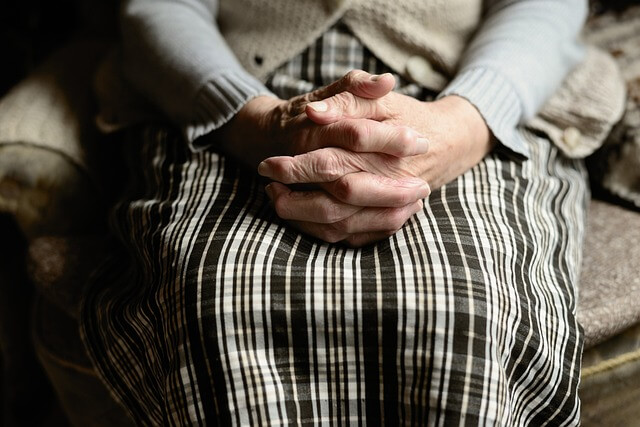
My son came home on the night of August 21, dressed in white, walking with a white cane in his right hand.
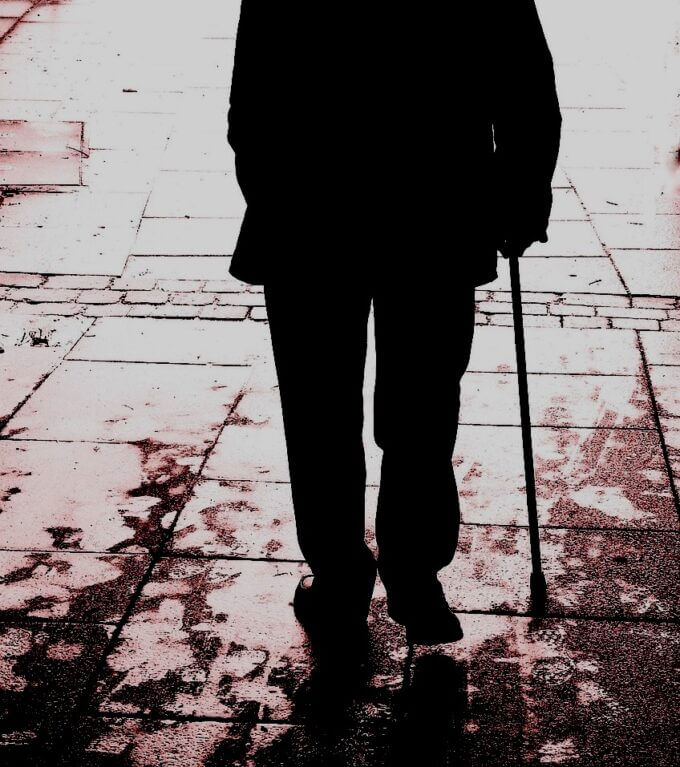
A week later, Nakai also appeared in Kimiko’s dream. In the dream, he only knocked on the window of the house and did not enter the house.
According to Kimiko, from the time Nakai was on military duty in Asahikawa, when he passed by the government housing area on his way to and from regimental headquarters and the Asahikawa Army Hospital, he would always knock on the window of the house, smile at her, and walk away, without stopping inside the house.
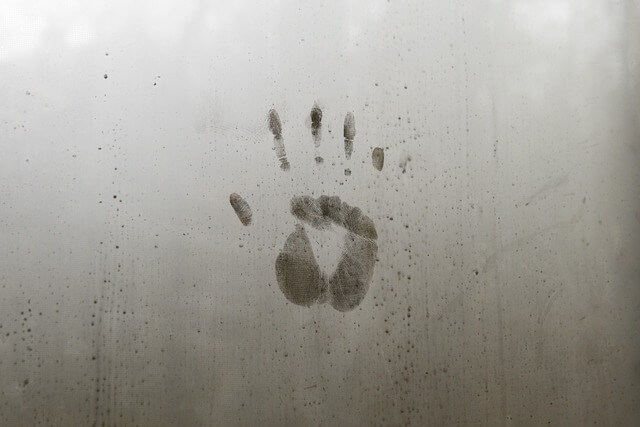
The Ghost of Soldiers Standing by Their Wife’s Bedside, Covered in Blood
Another officer’s wife said that while she was sleeping, her husband stood at her bedside in his bloody military uniform.
Oh, honey!
As soon as she called out to her husband, he quickly disappeared out of nowhere. She was so terrified that she could not get up for a while.

Another officer’s wife was asleep at midnight when she heard a voice calling out,
Ma’am, ma’am.
The soldier who had been her husband’s duty soldier stood at her bedside in his bloody military uniform.
Your husband has been honorably killed in action.
He reported to her in tears.

The above image is for illustration purposes.
She knew that her husband was regularly taken care of by this soldier, and she loved him like a brother. Therefore, she thought that the soldier had stopped by her superior officer’s quarters before returning to his own home to inform her of her husband’s death in battle.
And not long after, her husband also appeared in her dreams, also in a field uniform, covered in blood all over his body.
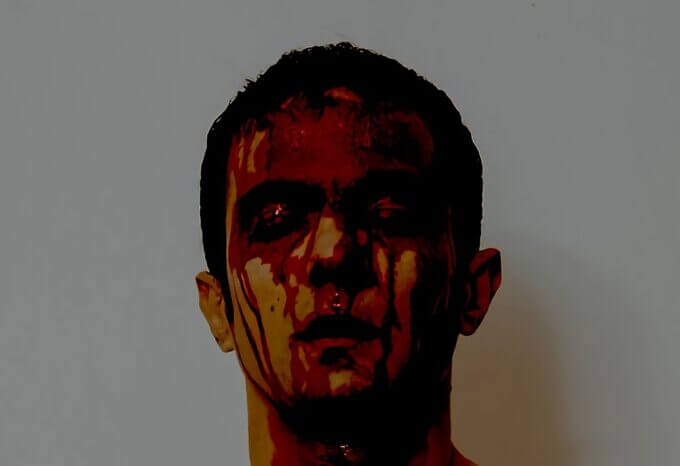
Thus, almost a week after the return of the ghost troops, the spirits of dead officers appeared one after another in the dreams of the officers’ wives in the government housing area.
The officers’ wives had never been informed by the military of the area in which their husbands were participating in the operation. So when one of the officer’s wives shared her experience of her husband appearing to her in a dream with the other wives, they began to tell their own mysterious stories.
Oh, did you have an ominous dream about your husband?
Actually, I had a dream about my husband coming home covered in blood, too.
The women then took each other’s hands and whimpered.

The wives were anxious about the safety of their husbands after seeing the ominous dream, and they visited Major Soga, the adjutant of the rusu division*1, and begged him to at least let them know of their safety.
At the time, Major Soga thought the story of the return of the ghost troops, which the soldiers had been making a fuss about, was merely a hoax. But, when he heard the pleas of a number of officers’ wives, he felt that something unusual was going on.
Major Soga himself did not know any accurate information about the Ichiki detachment beyond what was reported in the official telegram. In the Japanese army of the time, once a unit came under the direct control of the headquarters, the information about that unit was kept secret by the headquarters, and even the officers of the rusu division had no way of knowing about it.
However, some of the families of the Ichiki detachment learned that they had been killed in action on August 21, 1942, through a visit from a ghost soldier.
The Ghost of a Soldier Returned Home on the Night He Died in Battle
Lance Corporal Nobuo Sato (age 23 at the time of the war, corporal after his death), a native of Noto, Chirie Village, Shizuka County, Sakhalin, was drafted into active duty in April 1939.
According to the “three-year active duty Army service” provision of Japan’s Military Service Law, Nobuo was originally supposed to be discharged from the army in the spring of 1942, but he was transferred to the Ichiki Detachment and killed in action.
Sugawara, the author of ” The Annihilation of the Ichiki Detachment,” interviewed Nobuo’s sister, Kikuko, and learned a strange story from her.
On a morning in late August 1942, her father, Jinkichi, woke up and told the family as follows.

Nobuo came home last night.
He was standing outside my bedroom bay window and asked me to open the window.
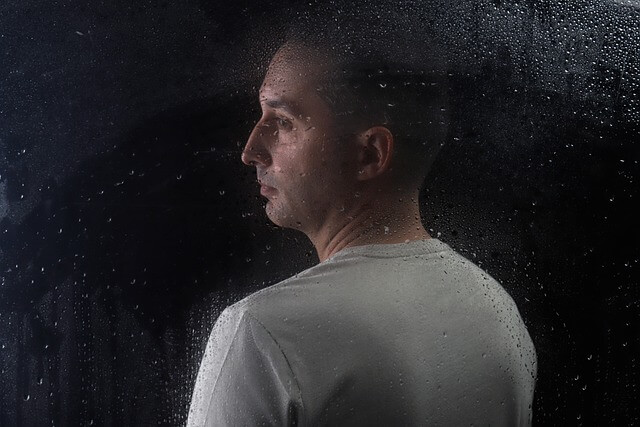
So I tried to open the window, but it wouldn’t open.
After some time, I couldn’t see Nobuo anymore.
I hope there is nothing wrong with Nobuo ……
Both her mother and Kikuko were surprised by her father’s sudden and ominous words, but the conversation stopped there because they did not want to mention it.
About a year later, when we had almost forgotten about it, the official notice of Nobuo’s death in battle was delivered to her family. Her father was devastated to learn of his eldest son’s death.

But something suddenly occurred to him, and her father brought out his diary from the previous year. It was a diary he had kept meticulously every day since he was a young man.

As her father flipped through the pages, he exclaimed loudly, “Ah!”
In the August 21, 1942 section of the diary, they found that Nobuo stood outside the bay window of his father’s bedroom late at night. To their surprise, August 21 was the very date that Nobuo’s death in the war had been confirmed in the official notice!
Kikuko described that day.
‘I had a premonition that Nobuo had been killed in action that day.’
My father was looking at the ceiling as if remembering the late-night incident a year ago.
At that moment, I think my father was trying his best to hold back the tears that were welling up.
But shortly after, when my father turned his face toward us, he burst into tears.

My mother and I both cried with grief.
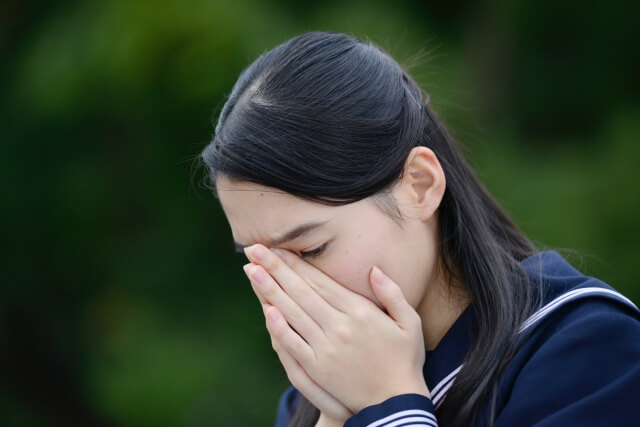
On the night they died in battle, the soldiers of the Ichiki detachment must have wished from the bottom of their hearts to see their families.
I believe that their earnest wish must have realized the miracle of these dead soldiers returning as ghosts to Japan, about 3,850 miles away from the battlefield.
This episode of the return of the ghost troops has been passed down among the Japanese people as one of the most tragic episodes of the war. I have written this article in the hope that as many people around the world as possible will share these mysterious but sad stories of the ghost troops.
Published on March 18, 2023
Written by OTAKUPAPA
References
1. Susumu Sugawara (January 1979) Ichiki Shitai Zenmetsu: Gadarukanaru Tou Sakusen Dainana Shidan Hohei Dai Nijuhachi Rentai (Annihilation of Ichiki Detachment : Operation on Guadalcanal Island, 28th Infantry Regiment, 7th Division), self-published.
2. Yozo Tamura et al. (May 1982). Yomiuri Shimbun Osaka Social Department, eds., Guadalcanal Shimbun Kisha ga Kataritsugu Sensou 14 (Guadalcanal: Newspaper Reporters Tell Tales of War 14), Yomiuri Newspapers.
3. Yozo Tamura (August 2015). Samayoeru Eirei Tachi Sensou no Kaiitan (Wandering Heroic Spirits: The Strange Tales of War), Chukou Shinsho.
4. Masayasu Hosaka (July 2008). Saikyo Sidan no Shukumei (The Fate of the Strongest Division), Mainichi Newspapers.
5. Masao Fujita (September 2011), Shasin de Miru Nihon Rikugun Heiei no Seikatsu (Life in the Japanese Army Barracks Seen Through Photographs), Kojinsha.



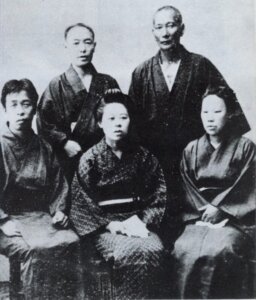

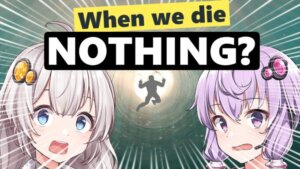
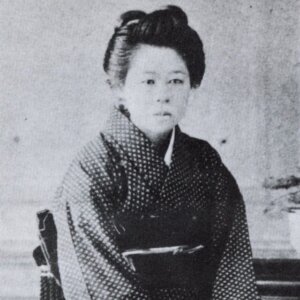
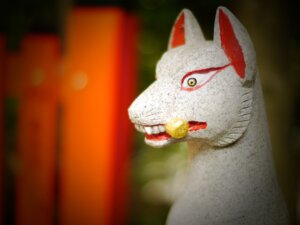

Comments